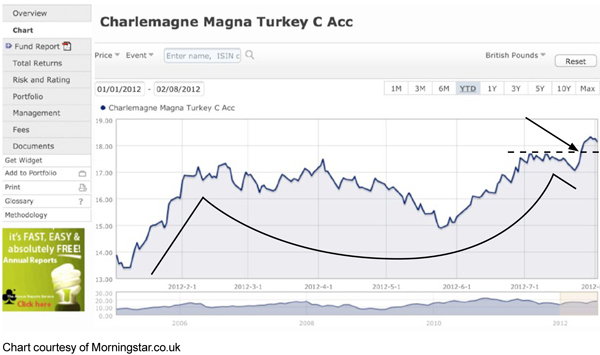 Are you looking for better returns from your ISA and SIPP investments? Most investors are looking to improve their returns but unfortunately the majority are unsure how to do it. Many think that it’s all about the funds they pick, but this is just one part of the equation. When people ask me my thoughts on ISA and SIPP investments, I always steer them towards 3 key points.
Are you looking for better returns from your ISA and SIPP investments? Most investors are looking to improve their returns but unfortunately the majority are unsure how to do it. Many think that it’s all about the funds they pick, but this is just one part of the equation. When people ask me my thoughts on ISA and SIPP investments, I always steer them towards 3 key points.
- Determine the market’s direction
- Find a quality fund
- Time your buys and exits
Determine the market’s direction
Bull markets are upwards trending markets and last between two and four years. Bear markets, the downwards trending markets, last approximately nine to eighteen months making their duration much shorter. As bull markets last longer, the stock market over the long term forms an upwards trend. In a typical cycle, you’d normally have three years up and then one year down. The bull/bear cycle then starts again and repeats continually throughout time.
May I ask you a question? Did you know that three out of every four stocks (and funds) move in the same direction as the market?
Yes it's true, so the returns of the funds you choose will always be directly linked to the market’s direction. That’s because funds own a large portfolio of stocks. This means if the market is trending up, three out of four funds will move up. However, if the market is trending down, three out of four funds will move down.
This means that even if you own a fund that is managed by one of the best fund managers in the world, if the market takes a dive that fund is also likely to take a dive. As legendary investor Jesse Livermore once stated: ‘Successful traders always follow the line of least resistance. Follow the trend. The trend is your friend.’
Did you know that 75% of the market’s movement comes from institutional investors?
Yes that’s also true. Institutional investors have the largest influence on the market’s future direction and institutional investors can be fund managers, banks, building societies or insurance companies. If these 800 pound gorilla investors are buying, smaller more nimble investors can jump onto their coat-tails. When institutional investors are selling, a private investor could quickly switch out on to the sidelines. Here's how it works. Picture the market as a large tree and try to imagine institutional investors being woodcutters. If institutional investors are selling heavily it is like them taking a cut out of the tree and this of course makes the tree weaker. If they take too many swipes at the tree in a short space of time, what is going to happen?
That’s right, the tree will fall over. This means the market gets weak when it succumbs to excessive selling, which results in raising a red flag. When heavy selling occurs, especially over a short period of time, it’s often a sign to say it’s probably the time to get out of the market and into the safety of a Cash Park. On the other hand, when institutional investors are buying heavily over a short period of time, this makes the market healthy and extremely strong and this is the optimal time to be invested.
Find a quality fund for your ISA and SIPP investments
I’m sure that you are aware that funds are managed and controlled by professional fund managers. The manager makes investment decisions on what companies to buy and what to sell. Investment performance is the most important element in fund selection. For example, I look at the fund manager’s long-term performance results and check to see if the manager has been managing the fund over the previous bull market period. I look for the date that the current fund manger started managing the fund, because it’s important to ensure that the current fund manager is the one who has scored the impressive results.
Ideally, I want to see the fund manager outperforming the Nasdaq Composite in bull market periods. Quality investment funds normally have four or five Morningstar stars. If a fund has three stars or fewer, I only give it a stamp of approval if the fund manager’s performance is exceptional. The investment fund can invest anywhere in the world but I prefer if the country the fund invests in has a strong and stable economy. When I scan for funds, I always look for ones outperforming the Nasdaq Composite. I like to invest in a fund that is diversified, but if I find a fund that has a speciality in say one or two sectors, I ensure they are sectors likely to lead in bull markets such as Internet, semiconductors, medical, telecom, retail, computer, metals and energy.
When the market is healthy, and it’s clearly in an upwards trend, one of the things I scan for is how funds are performing in the short-term. This short-term period action could be the previous day, week, month and possibly even the previous quarter. In my opinion, this is just as important as looking at the fund manager’s longer term performance.
Time your buys and exits
To help me accurately time buying, I like to look at the fund's chart pattern.

I look for classic chart patterns such as a cup-with-handle chart formation. The fund featured in this chart has what’s known as a ‘high handle’ and it has recently ‘broke out’. If you are not up to speed with technical analysis and you want to find out more about charts, I suggest you take a look at some books on technical analysis. William O’Neil’s, ‘How to Make Money in Stocks’ would be a good place to start.
When exiting a fund, I exit for two reasons. The first is when the fund is underperforming the Nasdaq Composite. The second reason for exiting is when a downtrend has been triggered. When an investor notices that the market trend has changed from up to down, they can proceed to bank their profits by switching out of equities and moving into cash.
One way to do this is to use a ‘Cash Park.’ This helps to protect against future losses. By parking your money in cash on a temporary basis, it means that even if the market crashes, your money will be safe. In fact, even though equity funds could be dropping like stones, a cash park will actually be rising in value. After parking in cash, an investor would simply sit, wait and be patient. Bear markets don’t last as long as bull markets, which means an active investor would be parked in cash for probably no longer than nine to eighteen months.
About ISACO
ISACO Wealth is a premium investment guidance based on what we are personally doing with our own money. Because we aim high, our service offers the potential for outstanding long-term returns combined with a warm, responsive and highly personal service.
To find out where an expert invests >>
To download the ISACO Wealth brochure >>
To start your 14 day free trial of ISACO Wealth >>
To discover 'A Golden Opportunity' >>















